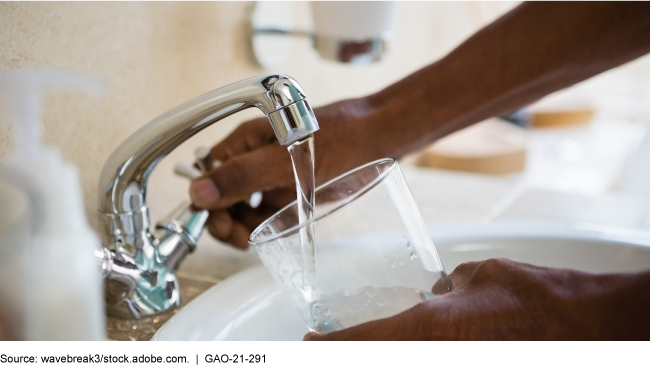Private Water Utilities: Actions Needed to Enhance Ownership Data
Fast Facts
More than 10% of the U.S. population gets drinking water from privately-owned water utilities and most states regulate the rates these utilities can charge. The utilities are owned by for-profit or nonprofit water companies, or other companies as part of another business. Utility ownership is one of many factors that can affect water rates and compliance with water safety standards.
We found that Environmental Protection Agency data on water utility ownership is inaccurate or outdated. Researchers and policymakers can use this data to help ensure drinking water safety and affordability. We recommended that EPA take steps to improve this data.

Highlights
What GAO Found
Available information on private for-profit drinking water utilities shows that 14 publicly traded companies served customers in 33 states in 2019. However, the Environmental Protection Agency's (EPA) primary source of publicly available information on U.S. drinking water utilities—the Safe Drinking Water Information System (SDWIS)—contains ownership information that is limited by inaccuracies. EPA collects information in SDWIS from states but does not include definitions for utility ownership types in its data entry guidance. In addition, EPA takes actions to verify some of the data, but does not verify or correct ownership data. EPA and others use SDWIS for purposes such as analyzing Safe Drinking Water Act violations by type of utility ownership. Such analysis can help EPA and states build utility capacity to provide safe drinking water. By defining ownership types, and verifying and correcting the data in SDWIS, EPA could help ensure the data are accurate and reliable for users of the data and the public.
EPA provided over $500 million in Drinking Water State Revolving Fund (SRF) assistance to for-profit utilities for 226 projects to help ensure delivery of safe drinking water from January 2010 through June 2020. EPA's Drinking Water SRF program, created under the Safe Drinking Water Act, provides grants to states for low- or no-interest loans or grants to drinking water utilities for infrastructure projects. The amount provided to for-profit water utilities is small, about 2 percent of the $26.5 billion provided overall from January 2010 through June 2020.
States That Provided Private For-Profit Utilities with Assistance from the Drinking Water State Revolving Fund, since January 2010

Why GAO Did This Study
The roughly 50,000 drinking water utilities in the United States face steep costs—more than $470 billion over the next 20 years, according to EPA estimates—to repair and replace drinking water infrastructure. These costs are passed on to customers through water rates. States regulate the rates charged by privately owned water utilities. EPA has responsibilities to implement programs to further the health protection objectives of the Safe Drinking Water Act.
GAO was asked to review private for-profit drinking water utilities and rates. This report examines, among other things, (1) information available from EPA and other sources about the number and characteristics of private for-profit water utilities in the United States, and (2) Drinking Water SRF assistance provided to private for-profit water utilities. GAO reviewed EPA SDWIS data, Drinking Water SRF data, and Global Water Intelligence data, as well as EPA's and others' documents. GAO also interviewed EPA and water utility stakeholders.
Recommendations
GAO is making two recommendations, including that EPA define all utility ownership types in SDWIS and verify and correct this data as needed. In written comments on the report, EPA generally agreed with both recommendations.
Recommendations for Executive Action
| Agency Affected | Recommendation | Status |
|---|---|---|
| Environmental Protection Agency | The Assistant Administrator for EPA's Office of Water should develop definitions for all utility ownership types for regional offices and states to use when entering data on ownership type in EPA's Safe Drinking Water Information System and should verify and correct the data as needed. (Recommendation 1) |
As of December 2024, EPA officials said they are currently working to modernize SDWIS (now called DW-SFTIES) and plan to incorporate the definitions into the updated version of SDWIS, which is expected to be available to states by early 2026. Officials also said that development of definitions will be in the later part of SDWIS development. GAO will review these actions when they are completed.
|
| Environmental Protection Agency | The Assistant Administrator for EPA's Office of Water should conduct another Community Water System Survey to establish an updated, accurate baseline of drinking water utility information for rulemaking and other purposes. (Recommendation 2) |
As of December 2024, EPA officials said they had initiated work to conduct another Community Water System Survey. EPA officials said they designed the survey in 2023 and held a focus group with small, medium, and large systems in 2024 to clarify and better define the data needed from the survey. Data collection is expected to begin in 2025. GAO will review agency documents and actions when they become available.
|
